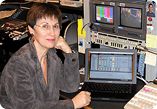Barbara Hagan: An Audio Daily Double

We can thank Wheel of Fortune and Jeopardy for some of the most recognizable sounds and melodies to come out of American television, and since 1993 Barbara Hagan has been working with a team to help bring those sounds to our ears. Based at Sony Studios in Culver City, California, Hagan sets up music playback, cue recording and sound effects that we hear in both shows. Recently, after years of struggling with unwieldy hardware solutions, she made the switch to Live and has since sped up her workflow, improved her storage system, and saved significant amounts of time and money. Below, Hagan explains her need to switch and what Live has meant for her productivity.
Cart Trouble
We started out using two of the 360 Systems new DigiCart IIs for music playback and recording and an Instant Replay (the prototype) for sound effects. The first problem I remember encountering was that the Digi II wouldn't play any of the Digi I's Bernoulli carts that I had brought over from CBS — wrong format! Very irritating, but ultimately I made new carts and moved on. This was the most current system at the time.
We used the carts until about the 2005-2006 season. We change the music often and add to it constantly. Wheel of Fortune has hundreds of cuts and many are on the spot edits. The DigiCarts needed defragging more and more often, as I recall, and the Bernoulli carts were starting to pile up. More and more people started to need copies of the library, which was very time consuming, and the carts weren't cheap. As the technology crept up on CDs and iPods and the like, and I was still recording new cues in real time, the whole system began to be unwieldy.
Solving the Puzzle
I began hearing around 2004, that some of the other Audio A2s around town were using computers to take the place of the Digis. As Wheel of Fortune and Jeopardy both travel about four times during any given season, it sounded like a great way to carry the libraries without having to bring a cartload of Bernoullis with me and download them every time into the Digis on the remote trucks. It was also the first time I was referred to your website to check out Live 4, and I started noticing all the advantages besides storage issues.

The mixer I work with, Cole Coonce, was very encouraging about making changes and streamlining all the various needs of both shows. I already had a Mac Powerbook, a Digidesign Mbox, and an 80GB portable hard drive. So I took a chance and bought the Live 4 program and began to learn it. I then started talking to the various producers and the Co-ordinating Producer/Technical Supervisor, Bob Sofia, about the time saved, the immediacy of the program when making edits, and how I could store, record and transfer data faster and more efficiently — basically save money and time and have enormous potential for growth. What's not to like?
I spent several weeks coming up with a template for both shows and transferring all the cues, then backing it all up on the portable hard drive (back up, back up, and more back up!). They let me use it — test drive it, really — on both shows, and after a while the Digicarts disappeared. We're now quite comfortable with the system, and I just smile every day.
Going Live
Now I have two computers with Live; one is my main computer (new MacBook with 2.16 processor), and one is a back up (G4 PowerBook). I currently use Live on both computers, and I'm constantly busy building cues during two days of taping, six shows a day, on Wheel of Fortune, five a day for Jeopardy. I transfer new cues from CDs right into iTunes, then edit them in Live. I transfer info to my backups with flash drives and build folders for post production use every day we tape. I store everything, and back up three times everywhere. Guess I've ended up being the keeper of the music, safe and intact. Sometimes it's pretty crazy, but mostly it's fun. And it all started because of Live!